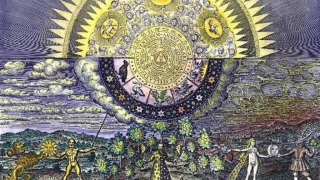Idolaters at the Freedom Shrine
We have spoken a lot in the past about the liberal progressive being a quintessentially religious being, as was recognized by Moldbug et al. This astute observation recognizes that liberal ideals form their own kind of dogma and function as a social religion, performing the same functions that any normal religion would, in placing restrictions on what is acceptable, branding heretics, and announcing the absolutes to which men must aspire. We have also mentioned that while most today don’t even recognize they are practicing this religion, there were some rather wacky attempts to formalize it in quasi-spiritual ritual practices such as those of the French Cult of Reason or Cult of the Supreme Being. However, while I had been under the impression that this was something of a temporary flight of fancy, I had been hitherto blind concerning just how in-your-face progressive pseudo-religiosity can be to this day.
What you see in the image above is what is known as a ‘freedom shrine’. Despite having lived in the United States for several years, I never encountered one, but was instead made aware of it only today, through an article at the increasingly badly written National Review. This article, entitled Who Americans Are was written by Jason Lee Steorts, a columnist whose takes are so bad, I beg P.T. Carlo not to profile him on Thermidor because it might encourage him to write more. Ironically enough, he penned an equally cringe-inducing article on Mencius Moldbug this week, which might as well have ended with “nothin’ personal, kid.” I will let someone else dig through that trash.
This piece is exceptionally drawn-out and boring by the author’s own standards, so it appears to be a manifesto of sorts, and thus worth addressing. Anyway, here is Steorts on the freedom shrine:
“The public schools of my youth always had a wall on which had been mounted something called the “Freedom Shrine.” The Freedom Shrine comprised replicas of various great documents of America, such as the Declaration of the Independence (sic), the Constitution, the Bill of Rights, Lincoln’s Gettysburg and second inaugural addresses, and Martin Luther King Jr.’s “I Have a Dream” speech. Maybe you have seen a Freedom Shrine as well; the National Exchange Club sells them to civic and educational institutions across the country.”
I did some research of my own to find that the National Exchange Club is a sort of community service organization catering mainly to children at risk as well as the elderly. It was started by merchants in 1911, and seems to be charitably funded, part of those funds going towards these displays which it sells to schools. The display is essentially a reliquary, as Steorts describes, containing the ‘holy’ documents of liberalism. I mean for crying out loud, it is called a SHRINE, which is specifically defined as a place of veneration and worship.
And so, Steorts relates to us this incredibly stupid religion as he waxes lyrical about how his country can be simultaneously ‘a people’ and ‘an idea’, with some added genuflection to Enlightenment principles. His primary value is procedural liberalism, and to this effect he states:
“So we think people have rights. Why do we think this? The answer must be that we think human beings matter. We think that human beings, regardless of their specific attainments and attributes, possess some kind of worth and dignity just because they are human beings. That is what the Declaration of Independence should be taken to mean in its assertion of human equality.”
This is why the Declaration of Independence is not worth trading for a scrawled crayon cartoon. Human beings do matter, certainly more than animals and rocks, but how does this translate into rights, and to what degree must something matter for it to be granted rights? How would a broad selection of things having significance automatically assert some equality between them in terms of rights? It is just an obvious fact that people’s attainments and innate attributes do impact how much they matter. A mother who cares for you will matter more than a mother who abuses you and neglects you. A man who fights with bravery clearly matters more than a man who hides in a foxhole. A sage who has opened his mind to the vast secrets of the universe definitely matters more than the village idiot. That doesn’t negate that all people matter in some sense because they have the Imago Dei, but it nixes equality outright. In fact, to equalize is to give some more than their due and others less. It is the definition of injustice.
Steorts then begins yammering about Jefferson and Kant, mentioning the imaginary and oxymoronic Judeo-Christian tradition, and says that our belief in human dignity is axiomatic, which means he doesn’t need to provide evidence for it. Now, that’s fine if the belief is able to stand on its own, but this particular belief clearly isn’t. It requires other prerequisites. In an atheistic world, he’s simply deluding himself and running away from nihilistic conclusions. Without God, man has no objective value, and God cannot be posited in the abstract but only through a living Tradition. If Steorts believed in that however, he’d find his own fantasy world, Jefferson, Kant, etc. to be at odds with God in every respect, regardless of which religion he cast his lot with. He continues:
“That conclusion implies that the freedom and good of the human individual — not that of government, or society, or the culture, or any tradition — are the purpose and measure of politics.”
Ah! Noble man, the great individual! All is for him! Culture and tradition, these are mere tools. Too bad this is ass-backwards. Man is, in almost all cases, a twisted little creature seeking at every juncture to indulge some wickedness against himself or his fellow men, or worse. He’s foolish, imprecise, weak, lustful, vengeful, greedy, arrogant, and lazy, to a greater or lesser extent, and the only thing that gives him any hope and any redemption in this life (never mind the next) is culture and tradition, with society and government being primarily in service to these things, and not to his pathetic little individual desires. He is to conform to the organic society, not the other way around, for the organic society is superior to him, the whole greater than the sum of each piece, and is the vehicle by which he is given meaning and a truly human life! In all but those most extraordinary cases of ascesis (in which the Divine is immediately close at hand), man exists because society keeps him: it clothes him, feeds him, bathes him, tells him what to say and what to do better than he himself could. Why? Because society, in its organic mode, has the wisdom of generations upon generations, and above all, the primordial wisdom of true religion. What does individual man have? The chittering thoughts in his brain informed by a few decades of life at most. Man is not the measure of politics. God is!
Steorts demands that we respect man “in his single majesty”. And what of God’s majesty, and those of the greatest amongst us, whom He hath given divinely enshrined authority through their own innate abilities? What of the majesty of kings and clerics? We must sacrifice all of these things for the majesty of the peasant and worse? But of course! And what “majesty” does Steorts afford such people? The majesty of Big Macs and standard fuck parties, Coca Cola and pornography. Our cups overfloweth with regality, kind sir! To the majesty of the everyman!
“Procedural liberalism thus could not be practiced in a society that believed in rule according to Scripture, or subject to the divine right of kings, or under a “revolutionary” party that forbade competitive elections, because then government would not be by the people but rather by some authority to which the people must submit themselves. Nor could procedural liberalism be practiced stably in a society that enforced a caste system, since it would be impossible to justify unequal treatment in the face of a nominal commitment to the universality of human dignity. This was the lesson that America’s founding evil, racial chattel slavery, imparted at an appalling cost in blood.”
I’ll give him points for honesty. He’s right. Procedural Liberalsm could never function under the rule of the best, nor of the Word of God, nor in a hierarchical structure of any description. The lesson here is that satanism cannot be practiced under sound, moral governance. And when he stops flagellating himself for “America’s founding evil”, which was only made possible by the degenerate mercantile perspective he himself is a poster-boy for, we’ll continue. He admits to being an apostate, though from which Church he neglects to say, so at least the adoption of his new shrine isn’t based on a Michael Coren level of duplicity. Now we get to the most egregious thing in this entire text:
“Suppose that elements of our culture are illiberal, or suppose they become so. What it means to be a liberal people is that in such cases we will take the idea as our guide. We will try to be truer to it. This provides an insight into the value, and danger, of traditions. Traditions are very often crystallizations of wisdom acquired gradually through the experience of many. But the traditional is not to be preserved simply because it is traditional, because traditions can also fossilize not just ancient inefficiencies but ancient hatreds, perhaps spiritualized into subtle and semi-aware forms, and must be subject to our ongoing practical and moral evaluation.”
“Ongoing practical and moral evaluation” means the whims and fancies of idiots and malcontents. Might ancient inefficiencies have arisen because of negative consequences of more efficient methods? Might ancient hatreds have a purpose? No way! Just bulldoze Chesterton’s fences because the higher the number of the year in which you were born, the wiser you are, and of course you are uniquely capable of assessing traditions in their practicality and morality. Marriage was instituted by God, but what does God know! Surely not more than our social ‘scientists’ who are well aware that this oppressive patriarchal institution should be opened first to profane mockery and finally to abolition. Steorts desperately tries to separate these issues later on, but falls victim to his own progressive logic trap. Slavery was refuted using his bogus claims about equal rights, and marriage can be refuted using exactly the same formula. He doesn’t get to pick and choose and claim there is a category error where there really isn’t. He’s just behind the curve.
In his attacks on the American AltRight, Steorts resorts to wishful thinking on the subject of prejudice, which I have addressed in detail here. He bats HBD science away as merely speculative or unsubstantiated, and even goes on to say that in the event that it were all true, he would still oppose the notion that races are inherently different. He heavily implies that people like Jared Taylor actively want to harm minorities, and goes on to say:
“There are times when certain kinds of group averages reasonably inform public policy. But such policies will not unjustly harm individuals. To respectfully police a geographic area with higher-than-average rates of violent crime, for example, is no harm to the dignity of its residents; it is the opposite. But to tell someone he should leave the neighborhood because his skin color correlates with violent crime in a statistically significant way — that is a grave affront to his dignity when he is no criminal.”
Imagine if he applied this same logic to America’s foreign policy. All the recipients of Agent Orange? Funeral bombings in Pakistan? The victims of state-department funded terrorists and goons in Syria and Ukraine? Were these people ‘unjustly harmed’, and if so, why is the moral calculation different? Is harm of the innocent only unjustifiable in public policy? If so, it would seem to contradict the equality of men. We’re dying to know what the explanation is here, beyond some variation of magic dirt.
“That I am white, by contrast, that I have a certain ethno-genetic ancestry — this means as little as that my eyes are blueish and my hair is brown.”
You might feel differently if you were being raped on the Cologne metro or murdered on your South African farm. Like all experienced manipulators, the apostate then appeals to our Lord Jesus Christ (as they all so often do), and his Sermon on the Mount, but let us quote from a portion of it directly:
“Beware of false prophets, who come to you in sheep’s clothing but inwardly are ravenous wolves. You will recognize them by their fruits. Are grapes gathered from thornbushes, or figs from thistles? So, every healthy tree bears good fruit, but the diseased tree bears bad fruit. A healthy tree cannot bear bad fruit, nor can a diseased tree bear good fruit. Every tree that does not bear good fruit is cut down and thrown into the fire. Thus you will recognize them by their fruits.“
Please tell me, if were to consider North Africa and the Middle East as trees, are they healthy trees or diseased trees? If they are healthy, why do their fruits want to leave them? We are told to be aware of false prophets. Is Muhammad a true prophet? Are Christians to accept this and treat his followers like sheep when they are in fact ravenous wolves, as they have demonstrated time and time again now in just the past month! Christ’s theme here is to beware of dangers both hidden and obvious. Don’t look at what people say they are, look at what they do! I go to Saint Ignatius of Antioch on heretics:
“But I guard you beforehand from those beasts in the shape of men, whom you must not only not receive, but, if it be possible, not even meet with.”
And yet, Steorts tells us to embrace the wolves as they rush towards us with dynamite beneath their coats, by entirely missing the point of the parable of the Good Samaritan. The point of the story is not to ceaselessly expand the definition of neighbour and extol the virtues of foreigners, nay the story would have no punch whatsoever and the Samaritan nothing remarkable about him if the Samaritans were in fact all wonderful and benevolent like our dear Islamic hordes of today. Instead, the point was what crappy neighbours Jews were being, when a foreigner behaved more decently and offered assistance to one of their kin, while they walked on for fear of uncleanliness (it’s no coincidence the two men who ignore the injured man are a priest and Levite, the ones who should know better). Thankfully, Steorts does then say that Christian values are essentially incidental. After all, the American idea is not contained in Scripture, but in the freedom shrine.
I won’t be the first to say it, but the freedom shrine is gay. I don’t mean gay as in sodomitic, I mean it as in excessively lame and facile. The writings of those great liberal heroes whom Steorts exhorts in his essay are not worth the paper they’re printed on, much less a display case for students to make pilgrimage to. It’s part of a religion fit for empty-headed, bourgeois idealists, men like Simon Jenkins who think their ballot is sacred (honestly read this, it’s hilarious). I’m convinced there is some kind of ecstasy on the part of these people who conceive of their purely quantitative societies in sacral terms, and the warm feeling it arouses makes them immediately suspicious of latter-day Calhounists and the like. If only those poor souls could have their eyes opened to the majesty of these values, they might learn to embrace their group’s eradication. Liberals of every stripe just love to imagine they have found some transcendental principle in the cult of the individual, but it is all as demonstrably hollow as Steorts’ skull.
A freedom shrine is an affront to God, an affront to everything higher and more noble than the repugnant philosophy which furnishes procedural liberalism. It’s a symbol of our bondage to the lowest common denominator, our bondage to swine who bring terror and calamity upon us from abroad, but most of all it is a symbol of our bondage to a toxic thought of societies based on ideas. We’ve had enough ideas. We want roots, thick and strong, clawing into the dirt beneath our feet and sustaining trees which reach towards the heavens. And to plant a tree, you need fertile soil, which we all know is produced in great quantities by a good fire. How to get one going? Well, I think I’ve found some shrines we can burn.
Source: Thermidor Magazine











